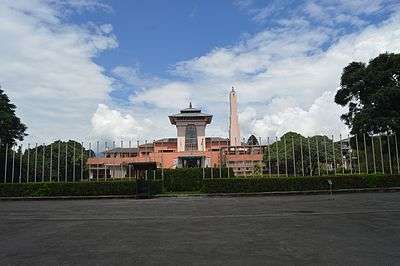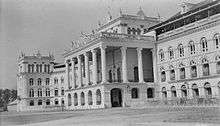Narayanhity Palace
| Narayanhiti Royal Palace | |
|---|---|
 | |
| General information | |
| Town or city | Kathmandu |
| Country | Nepal |
| Construction started | 1961 |
| Client | Dhokal Singh Basnyat,King Mahendra, Bir Shumsher JBR |
| Owner | Government of Nepal |
| Technical details | |
| Structural system | Brick and Mortar |
| Size | 38 hectares (94 acres) or 753 ropanis |
| Design and construction | |
| Architect | Benjamin Polk |
Narayanhiti Palace, or Narayanhiti Durbar (Nepali: नारायणहिटी दरवार) is a palace in Kathmandu, which long served as residence and principal workplace of the reigning Monarch of the Kingdom of Nepal. Located in the capital city of Kathmandu, the palace was the centre of state occasions and royal hospitality.[1][2][3] The palace complex is located towards east of the Kaiser Mahal next to Thamel, and is incorporated in an impressive and vast array of courtyards, gardens and buildings. The current Narayanhiti Durbar was built by King Mahendra in 1961.[4]
Etymology
The name, ''Narayanhiti'' is made up of two words ‘Narayana’ and ‘Hiti’. Narayana is the Hindu god Vishnu, whose temple is located opposite to the palace. ‘Hiti’ means “water spout” in Newar language, which is also located to the east of main entrance in the precincts of the palace, a landmark that features prominently in local legends.
History
First houses on the site
During the early Shah period, the site of the future Narayanhiti Palace was occupied by family of shreepali basnyat [Kaji Dhokal singh Basnyat]]'s house. Ownership of the site changed hands many times;after Dhokal singh Basnyat the site was occupied by Chautariya Fateh Jung Shah ( 6thPrime Minister of Nepal), his father courtier Choutaria Pran Shah and family.[4] During Kot massacre of 19 September 1846 both Prime Minister Chautariya Fateh Jang Shah along with his father Choutaria Pran Shah and brothers were killed or send in exile out of Kathmandu.After this massacre Narayanhiti Palace was taken over by Jung Bahadur Rana's brother future Prime Minister then colonel Ranodip Singh Kunwar. Colonel Ranodip Singh ordered minor renovation of the old palace of Choutaria Pran Shah and used it as his private residence.After ascending the throne of Prime Minister Maharaja in 1877, Narayanhit Durbar was again renovated, but this time much lavish and was extended into multi-wing palace[4] On 22 November 1885 during a coup d'état Prime Minister Maharaja Ranodip Singh Kunwar was assassinated by his nephews,The Sumsher brothers[5](Khadga Shumsher, Chandra Shumsher, and Dumber Shumsher) somewhere in the southern wing of this palace.[4][6]
Home of the monarch

After the death of Prime Minister Maharaja Ranodip Singh Kunwar, on 22 November 1885 Bir Shumsher JBR assessed the throne of Prime Ministership and took over the Narayanhiti palace of Ranodip Singh.In 1886 Bir Shumsher uprooted the whole Narayanhiti palace and build a new palace under the master Nepalese architect Jogbir Sthapit for his Son-in-law Maharajadhiraj King Prithvi Bir Bikram Shah.Thus moving the Royal residence of reigning Monarch of Kingdom of Nepal from Hanuman Dhoka Durbar to Narayanhiti Durbar[4]
Earthquake of 1934
During 1934 Nepal–Bihar earthquake Narayanhity Palace was partially damaged killing two infant Princess, daughters Princess of King Tribhuvan. Repair and renovation work was done under Colonel Engineer Surya Jung Thapa and a new Portico and Grand Staircase was built.[4]
Current Palace
In 1961, King Mahendra ordered the demolition of old palace and construction of new palace. The new palace was built in Nepalese architecture style under the design of Californian architect Benjamin Polk.[7][8] Decade-long construction of the palace ended in 1970. The Griha Praves in the new palace was done on the occasion of the Hindu wedding ceremony of Prince Birendra the then-heir apparent to the throne on 27 February 1970.[8]
Interior
The Palace stands on the floorspace 3,794 m² (40838.28 sq ft) and is divided into three parts, the guest wing, the state wing and the private wing. Narayanhity Palace has 52 rooms called sadan and are named after 75 Districts of Nepal. Interior of the palace is based on Late Victorian style[9]
Reception Hall
Reception Hall of Narayanhiti palace is named after Kaski District as Kaski Sadan.The hall is decorated with two full size taxidermy Bengal tiger in charging posture hunted by King Mahendra and king Birendra along with life-size portraits of the Shah Monarchs throughout the stairs by artist Amar Chitrakar. Gaurishankar Gate opens to Kaski Sadan and it is in Kaski Sadan where Shah Monarchs of Nepal gave audience to politicians and perform oath ceremony of Prime Minister and heads of constitutional bodies for Kingdom of Nepal.
The Throne Room
The throne room Gorkha Baithak in Narayanhiti Palace is the center of the entire palace. It is right above Kaski Baithak. Construction of Gorkha Baithak is based on Hindu temple architect style with a 48 feet Chandelier hanging on a 60 feet high Pagoda style ceiling standing on four concrete columns representing Nāga, decorated with garish Hindu deities Astha Matrikas and Ashta Bhairava. It is under this high ceiling where Throne of Kingdom of Nepal was placed.It is this room where the Monarch, on special occasions, gave the royal Royal Proclamation.[4] To the right of the Gorkha Baithak, is Dolpa Sadan and was used as the room for the un-invited guests of royal family to view proceedings of Gorkha Baithak through a one-way viewing mirror.
Ownership
In 1972 King King Mahendra sold Narayanhiti Palace to the government of Nepal for 70 million Nepali Rupees (seven crore, सात करोड in Nepali currency) claiming that the property was a dowry given to his paternal grandmother while marrying his grandfather, King Prithvi Bir Bikram Shah.[4]
Court Ceremonies
Court Ceremonies Narayanhiti durbar was held in Dhanusha Baithak where the king used to award decorations. It was used for teeka and darsan during Dashain by the royal family and for high level government and military officials.
Massacre
It was in Narayanhiti palace where the scene of the 2001 Nepalese Royal Massacre took place.
Current Status
After the 2006 revolution toppled the monarchy, the newly elected assembly declared Nepal as a republic country and King Gyanendra was forced to vacate the palace within 15 days.[10] The royal palace is now turned into a public museum. The crown jewels are considered to be among the most precious and valuable objects in Nepal.
See also
References
- ↑ http://www.tripadvisor.com.au/Attraction_Review-g293890-d3382704-Reviews-Narayanhiti_Palace_Museum-Kathmandu_Kathmandu_Valley_Bagmati_Zone_Central_Region.html
- ↑ https://www.theguardian.com/travel/gallery/2009/may/25/nepal-royal-family-palace-museum
- ↑ https://www.theguardian.com/travel/2009/may/26/nepal-royal-palace-museum
- 1 2 3 4 5 6 7 8 JBR, PurushottamShamsher (2007). Ranakalin Pramukh Atihasik Darbarharu [Chief Historical Palaces of the Rana Era] (in Nepali). Vidarthi Pustak Bhandar. ISBN 978-9994611027. Retrieved 2015. Check date values in:
|access-date=(help) - ↑ Gorkhas: The Warrior Race. Gyan Publishing House. 2009. pp. 204–. ISBN 978-81-7835-776-8.
- ↑ JBR, PurushottamShamsher (1990). Shree Teen Haruko Tathya Britanta (in Nepali). Bhotahity, Kathmandu: Vidarthi Pustak Bhandar. ISBN 99933-39-91-1.
- ↑ "The Architecture of Power: Some insights into the Narayanhiti Palace Museum". 2014-03-08. Retrieved 2015-10-12.
- 1 2 Mark Tushnet; Madhav Khosla (21 August 2015). Unstable Constitutionalism: Law and Politics in South Asia. Cambridge University Press. pp. 74–. ISBN 978-1-316-41908-3.
- ↑ "General information about Narayanhiti Palace Museum". 2012-04-24. Retrieved 2015-10-12.
- ↑ "nepal/kathmandu/sights/museums-galleries/narayanhiti-palace-museum".
Coordinates: 27°42′56″N 85°19′12″E / 27.7156°N 85.3200°E
